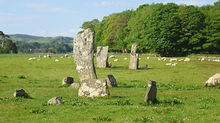Discover Dál Riata- Argyll's ancient kingdom
- Imagine Alba
- Sep 14, 2020
- 2 min read
Updated: Oct 27, 2022
The landscape of Scotland just oozes history, and few places more so than in the west Highlands area known from ancient times as Dál Riata.
It is Gaelic for “portion of land belonging to Riata,” possibly referring to a share of land ruled by a person named Riata, which may mean horseman. The kingdom once encompassed what is now Argyll and Bute, Lochaber and County Antrim in Ulster, Ireland.

Kilmartin Glen is ground zero for Dál Riata's rich archaeological remains. A trip to Kilmartin House Museum of Ancient Culture is very informative and holds an impressive collection of artefacts.
At the heart of the charming village of the same name is the Kilmartin Church and graveyard. The church dates to the mid 1800’s, but there has been one on the site for much longer. Scattered throughout the yard, in an outbuilding and in the church itself is a striking collection of early Christian and medieval carved grave markers known as the Kilmartin Stones. Among the most impressive is a set of Celtic crosses that stand in the church, which date to around the 9th century and the late medieval period. Most of the gravestones in the churchyard and outbuilding date to between the 14th and 16th centuries. They are intricately carved figures of knights with spears and swords, foliage, Celtic patterns and fantastical animals in what is called the West Highland style.

The glen itself is home to over 150 megalithic monuments- cairns, standing stones and rock art dating back over 5,000 years. The area rivals Orkney for spectacular prehistoric ruins, and its setting is glorious in any season, nestled beautifully among the emerald hills above the great Moine Mhor or “Great Moss” bog. A sign off A816 directs visitors to the Temple Wood car park, from where you can stroll through the sheep paddocks and around the megaliths- a stone henge circle, burial cairns, cup and ring marked rocks.
You can spend all day exploring the site. Seasonal rituals are held here even today, such as a Spring Equinox programme, complete with storytelling, music, art and fire dancing among the standing stones. Local custom says it’s unlucky to touch the stones in the circle.

Nearby is Dunadd- the ancient seat of the kings of Dál Riata. From the car park, it’s a steep ascent to the top on foot. This “Fort on the River Add”, occupied since at least the 7th century, is an imposing site, with a commanding view over Moine Mhor and the river. A clearly visible footprint on a stone at the top is said to have played a part in the inauguration of early kings. If you look closely, you’ll see faded carvings on stones around the upper enclosure, including a Pictish style boar and Ogham script.
Moine Mhor is a National Nature Reserve and one of Britain’s best boglands. A paved, wheelchair accessible path winds through the moss covered trees with a boardwalk out over the bog, looking out to Dunadd, and there are picnic tables. Nearby, a forestry trail winds around Achnabreac prehistoric rock art, which will astonish you with its mysterious carved symbols.
If you love to get off the beaten path, add Dál Riata to your bucket list, where thousands of years of fascinating history come to life.









































Comments